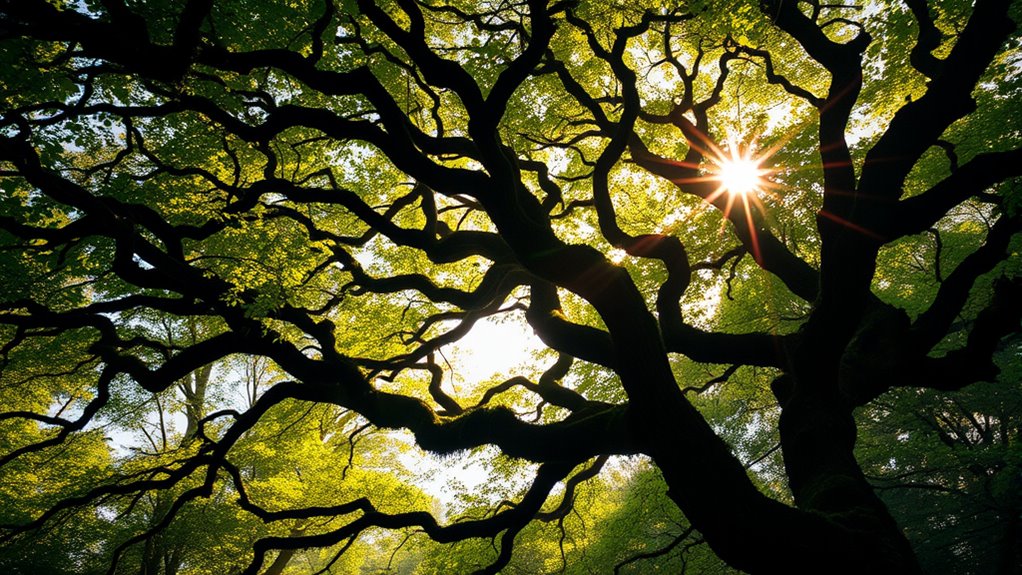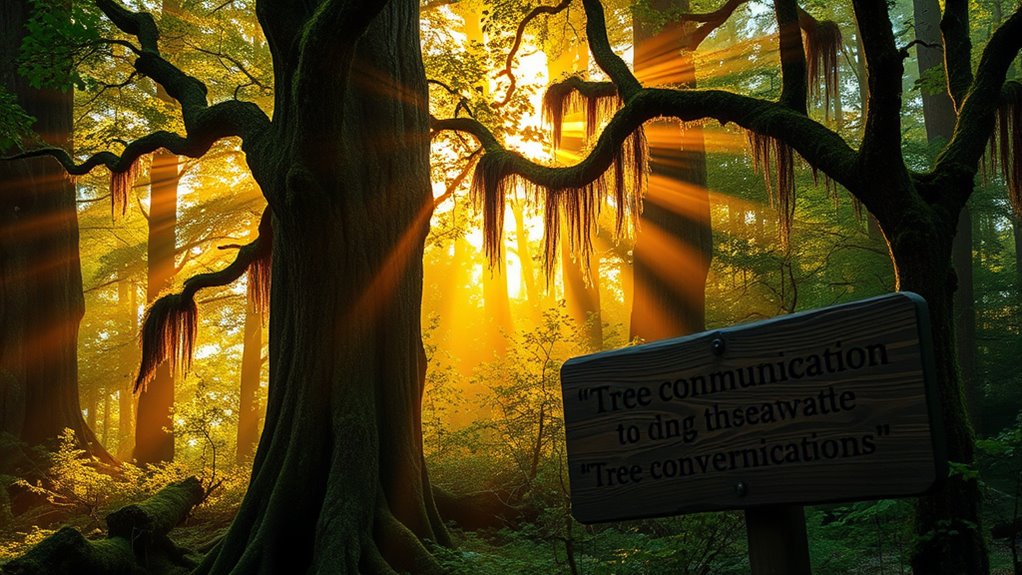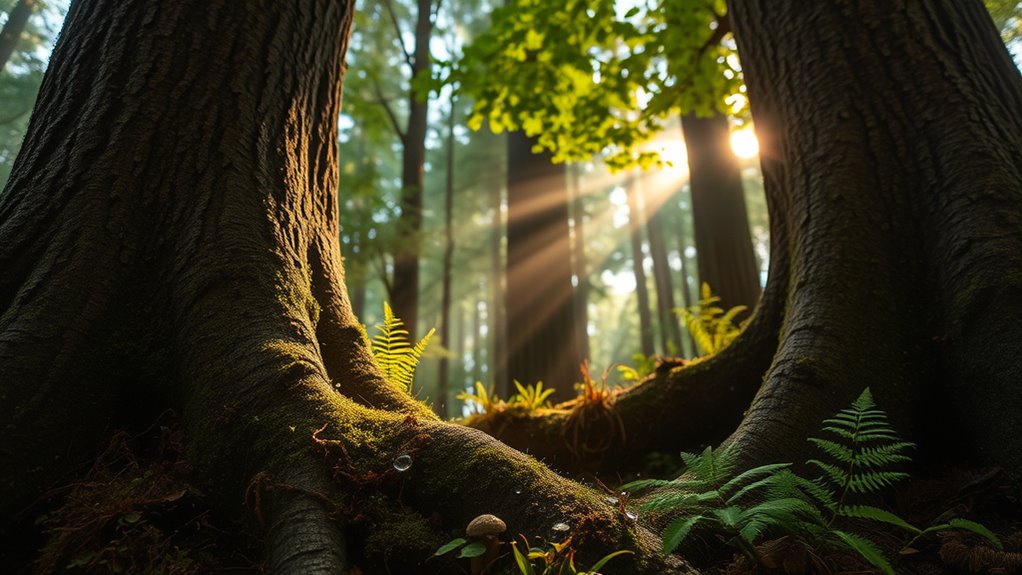Trees talk through underground networks with fungi, chemical signals, and vibrations, creating a silent yet complex conversation. They warn each other of dangers, share resources, and respond collectively to stress, revealing a deep intelligence. Ancient quotes and recent science show these natural signals embody a hidden language of resilience and cooperation. If you’re curious, you’ll discover the forest’s secrets and the incredible ways trees communicate beyond what meets the eye.
Key Takeaways
- Trees communicate silently through underground mycorrhizal networks, sharing resources and warning each other of stress or danger.
- Chemical signals and vibrations act as messages, alerting nearby trees to threats like pests or drought conditions.
- Leaf color changes and vibrations serve as internal signals, revealing trees’ health and environmental responses.
- Forests function as collective entities, with trees sharing knowledge and resilience through subtle, ancient communication methods.
- Quotes and natural insights emphasize that trees possess deep intelligence, engaging in complex dialogues for survival and harmony.
The Underground Network: Roots and Fungi Communicating

Beneath the forest floor, roots and fungi form a complex underground network that enables them to communicate and share resources. This system is known as mycorrhizal networks, where fungi establish fungal symbiosis with tree roots. These networks act as biological internet, allowing trees to exchange nutrients, water, and chemical signals. When a tree is stressed or injured, it can send signals through this fungal communication system, alerting nearby trees to prepare defenses or adjust growth. The fungi connect different plants, creating a cooperative community beneath your feet. This underground network highlights how trees aren’t isolated but part of a larger, interconnected system. Additionally, the symbiotic relationship between fungi and trees enhances the overall health and resilience of forests. Understanding mycorrhizal networks reveals the hidden, cooperative relationships that sustain forest health and resilience.
Chemical Signals: How Trees Warn Each Other of Danger

Trees have a remarkable way of communicating danger through chemical signals released into the air and soil. When a tree detects harm, such as insect attack or disease, it responds by emitting specific chemicals that travel through the environment. These signals alert nearby trees, activating their plant defenses and preparing them for potential threats. This form of chemical signaling is an efficient survival strategy, enabling forests to respond collectively rather than individually. The chemicals act like warnings, prompting other trees to produce protective compounds or strengthen their immune responses. This plant communication fosters a sense of interconnectedness among trees, allowing them to work together to improve their chances of survival. By sharing essential information through these subtle cues, trees create a dynamic network of communication that helps the entire forest community withstand dangers. This silent dialogue showcases nature’s sophisticated methods of cooperation and resilience.
The Symphony of the Forest: Sounds and Vibrations as a Language

You might not realize it, but the forest is alive with hidden melodies and subtle vibrations that carry messages. These natural sounds and signals form a complex language trees use to communicate and share information. Exploring this symphony reveals a fascinating world where sound becomes an essential part of forest life. Interestingly, some researchers suggest that understanding these sound-based communications could lead to new insights into forest health and resilience.
Nature’s Hidden Melodies
The forest is alive with a complex symphony of sounds and vibrations that often go unnoticed. Beneath the surface, trees communicate through these subtle signals, which are closely tied to their photosynthesis processes. As leaves convert sunlight into energy, they also produce vibrations that can travel through branches and roots, creating a hidden melody. Variations in leaf color, like changing hues in autumn, aren’t just visual; they reflect shifts in the tree’s internal signaling and health. These color changes can signal stress or adaptation, transmitting messages through vibrational patterns. By tuning into these melodies, you begin to understand how trees share essential information, orchestrating a silent yet intricate dialogue that sustains the forest’s harmony. Effective wall organization systems and visual cues in the environment can help us better interpret these natural messages and appreciate the forest’s intricate communication network.
Subtle Vibrational Signals
Have you ever wondered how the forest communicates without words? It’s through subtle vibrational signals that travel through the trees and soil. You might not see it, but leaves respond to vibrations caused by wind or nearby activity, a form of photosynthetic signaling. When a tree’s leaves vibrate, it isn’t random; it’s a message indicating stress, nutrient needs, or even warning others of danger. These leaf vibrations can send information about environmental changes, helping trees coordinate responses and share resources. These signals are part of an internal communication network that allows trees to respond collectively to their environment. This silent language operates beneath our awareness, forming a complex network. By sensing these vibrations, trees effectively “talk” through physical signals, revealing a hidden, intricate dialogue that sustains the forest’s delicate balance.
Communicating Through Sound
While much of a forest’s communication remains hidden beneath the surface, sounds and vibrations play a vital role in how trees and plants share information. You might not see it, but leaf communication often involves subtle sounds produced by the movement of leaves or the release of chemical signals that generate vibrations. These vibrations can alert nearby trees to drought, pests, or other threats, prompting tree conversations that strengthen defenses or prepare for changes. Researchers have even recorded low-frequency sounds emitted during stress, revealing that trees are more vocal than we realize. By listening to this symphony of vibrations and sounds, you gain insight into the forest’s hidden dialogue—an intricate, ongoing conversation that sustains the ecosystem’s health and resilience. Understanding plant communication can deepen our appreciation of how ecosystems function and adapt.
Wisdom From the Canopy: Ancient Quotes on Tree Communication

You can sense that trees communicate silently through nature’s quiet conversations. Their wisdom runs deep in roots and branches, holding secrets passed down through generations. The forest’s ancient voice reminds us to listen closely to the messages hidden in the canopy. For those seeking to embody the charm of nature, choosing a dog names that reflect the spirit of the forest can be a meaningful tribute.
Nature’s Silent Dialogues
Beneath the rustling leaves and towering branches, trees engage in a quiet dialogue that often goes unnoticed. Their leaf arrangement isn’t random—it’s a sophisticated system optimized for light absorption and communication. This silent exchange helps trees share crucial information, like warning signals or resource needs, without words. Over centuries, trees develop remarkable longevity by relying on these subtle interactions, maintaining harmony within their forest community. Their ability to “talk” through chemical signals and canopy connections showcases an ancient wisdom, revealing how they adapt and survive. These communication methods are vital for their survival and demonstrate the importance of ecosystem interconnectedness. You might not see this dialogue, but it’s ongoing and essential, ensuring the forest’s health and resilience. These silent conversations highlight the profound intelligence rooted deep in nature’s canopy, whispering secrets of survival and cooperation.
Wisdom in Roots
Roots serve as the hidden channels of wisdom that connect trees to their environment and each other. Through mycorrhizal networks, these underground systems form extensive connections, enabling trees to share nutrients and information. Root signaling plays a crucial role, allowing trees to communicate stress, disease, or resource needs silently and efficiently. Natural materials emphasize the authenticity and resilience of these networks, highlighting their evolutionary significance. Ancient quotes often emphasize the deep intelligence rooted beneath the canopy, revealing that trees are far from silent. Instead, they engage in complex dialogues through their roots, fostering cooperation and resilience within the forest. This underground communication system highlights the forest’s collective intelligence, reminding us that wisdom isn’t always visible but often rooted in unseen, intricate networks. Your understanding of these hidden exchanges deepens your appreciation of the forest’s silent, yet profound, wisdom.
Forest’s Ancient Voice
While roots quietly whisper beneath the forest floor, the canopy above hums with a different kind of wisdom—an ancient voice that echoes through time. Here, trees reveal their resilience, standing tall through storms and droughts, whispering stories of survival. Leaf symbolism plays an essential role; each leaf serves as a messenger, conveying messages about health and environmental changes. These ancient quotes remind us that trees are more than silent giants—they’re ancient storytellers, sharing knowledge across generations. The resilience seen in their sturdy branches and resilient leaves symbolizes strength and adaptability. Listening to the canopy’s voice, you realize that trees have long been communicating, guiding us with their silent wisdom rooted in centuries of survival and growth. Additionally, crochet styles for locs demonstrate how protective styling can mirror the natural resilience of trees, emphasizing strength and versatility in design.
Modern Discoveries: Science Unveiling Forest Conversations

Recent scientific breakthroughs have shed light on the intricate ways trees communicate, transforming our understanding of forest ecosystems. Researchers now know that trees share information through chemical signals, especially during photosynthesis processes. For example, when a tree detects stress or pests, it can alter leaf coloration, signaling nearby trees to prepare defenses. These changes aren’t random; they’re part of a complex network where trees exchange messages via underground fungi and volatile compounds. By studying these signals, scientists uncover how forests maintain balance and respond collectively to threats. You might think of trees as silent giants, but in reality, they’re actively talking—sharing messages essential for survival and resilience. Modern science reveals that forest communication is a sophisticated, interconnected system, far more dynamic than previously imagined.
Lessons From Trees: What Their Secrets Teach Us About Connection

Trees demonstrate that true connection goes beyond individual survival; they thrive through cooperation and communication. They share resources via underground networks, showing us that connection supports collective strength. Their photosynthesis processes rely on leaf coloration patterns, which adapt to sunlight and environmental changes. These patterns aren’t random—they signal health, stress, or readiness to share nutrients. By observing trees, you learn that openness and responsiveness foster resilience. Just as leaves change color to communicate internal states, your connections can reveal your true self and needs. Trees teach us that understanding and cooperation create harmony, enabling growth even in tough conditions. Their secrets remind you that genuine connection requires awareness, sharing, and mutual support—lessons that apply just as much to human relationships as to the forest ecosystem.
Frequently Asked Questions
Do Trees Communicate With Animals or Insects as Well?
You might wonder if trees communicate with animals or insects. They do, using root networks and chemical signals. Through these systems, trees send messages about danger or resources, alerting insects or animals nearby. Insects like bees or beetles respond to these signals, helping with pollination or pest control. So, trees actively share essential information, creating a hidden network that benefits both flora and fauna in the forest ecosystem.
Can Humans Interpret Tree Communication Directly?
Imagine you’re a 19th-century explorer, marveling at the forest’s secrets. While you can’t directly interpret tree communication, you can observe signs like root symbiosis and sap flow signaling. These clues hint at complex messaging between trees. Scientific advancements now help us understand these signals, but true ‘reading’ requires tools. So, humans can’t fully interpret tree communication yet, but we’re getting closer to uncovering their silent language.
Are All Tree Species Capable of Communicating Underground?
You might wonder if all tree species can communicate underground. Many do, using mycorrhizal networks to connect roots and share information. Through chemical signaling, trees warn each other of pests or stress, creating a hidden communication system. While not every species is equally connected, the majority rely on these underground networks to support the forest’s health and resilience, revealing nature’s complex, cooperative communication system.
How Do Environmental Changes Affect Tree Signaling?
Environmental changes, like shifts in soil nutrients and climate stress, markedly impact how trees signal each other. When soil nutrients decline or climate stress increases, trees may weaken their communication or alter their signaling methods to conserve energy. You’ll notice that under such conditions, trees become less responsive to neighboring signals, which can hinder their ability to warn others of dangers like pests or drought.
Is Tree Communication a Sign of Intelligence or Consciousness?
You might wonder if tree communication indicates intelligence or consciousness. While plants show signs of plant cognition and forest awareness, it’s not clear if they possess true intelligence or consciousness like humans do. Instead, their signaling systems evolved to survive and adapt. So, rather than viewing it as intelligence, see it as a sophisticated form of plant communication that enhances their ability to respond to environmental cues and foster forest health.
Conclusion
Now that you’ve uncovered the forest’s secrets, it’s clear that trees aren’t just silent giants—they’re talking to each other in ways we’re only beginning to understand. From underground networks to vibrations, they share wisdom and warnings, reminding us that nature’s best lessons often come from quiet conversations. Keep your ears open and remember, sometimes the best communication happens when you’re willing to listen between the lines. Nature’s talking—are you ready to hear it?
Joy, as our Editor in Chief, ensures the highest standard of content. Her talent in writing is complemented by her attention to detail and passion for literature and culture. Joy’s expertise and love for the English language shine through in her editorial work, making each piece a testament to quality and clarity.










